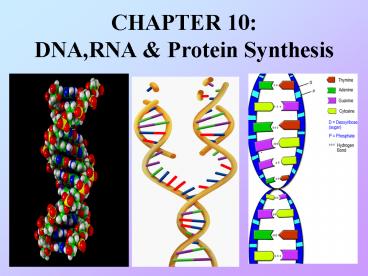CHAPTER 10: DNA,RNA - PowerPoint PPT Presentation
1 / 23
Title:
CHAPTER 10: DNA,RNA
Description:
CHAPTER 10: DNA,RNA & Protein Synthesis I. Discovery of DNA Scientist originally believed PROTEINS would be the molecules which contained hereditary information. – PowerPoint PPT presentation
Number of Views:296
Avg rating:3.0/5.0
Title: CHAPTER 10: DNA,RNA
1
CHAPTER 10 DNA,RNA Protein Synthesis
2
I. Discovery of DNA
- Scientist originally believed PROTEINS would be
the molecules which contained hereditary
information. - Some scientists who did experiments that proved
DNA had genetic information - 1. Fredrick Griffith
- 2. Oswald Avery
- 3. Hershey Chase
3
James Watson Francis Crick
- In 1953 DNA structure discovered
- Double Helix model.
- (2 chains of DNA)
- Showed how DNA could replicate.
- Relied on work of other scientists
- Rosalind Franklin Maurice Wilkins took X-ray
photos of DNA structure - ( Franklin died 1958 before Watson Crick
received Nobel Prize. 1962.)
4
II. DNA structure
- Double Helix shape is formed by base pairs
attached to a sugar-phosphate backbone. - -
5
B. Parts of Nucleotides
- 1. 5 carbon sugar in DNA- deoxyribose
- (in RNA ribose)
- 2. phosphate group
- 3. nitrogenous bases ( there are 4 different
ones) - Adenine
- Guanine
- Cytosine
- Thymine
- (in RNA- no thymine- Uracil is the base)
6
C. How Chemical Bonds hold DNA together
- Covalent bonds- between sugar phosphates of 2
nucleotides - Hydrogen bonds- between complementary nitrogenous
bases
7
D. Base Pairing Rules
- Adenine always bonds with Thymine (AT)
- Guanine always bonds with Cytosine (GC)
- Note 3 hydrogen bonds GC
- 2 Hydrogen bonds AT
8
- Must have 1 purine (a 2 ring shape) plus 1
pyriomidine (1 ring shape) in each pair or the
would not fit inside ladder of DNA - 2. Purines (A, G) double C ring
- 3. Pyrimidines (T, C) single C ring
9
III. DNA Replication
- A. Is the process by which DNA is copied in a
cell before a cell divides by mitosis, meiosis or
binary fission.
10
B. Steps in Replication
- 1. Helicase enzymes -separate hydrogen bonds in
strands create replication fork - 2. Attach- DNA polymerase enzyme -adds
nucleotides - 3. Release DNA polymerase enzyme now have 2
identical DNA strands
11
C. Errors
- DNA replication is very accurate.
- Errors occur 1 in 1 billion paired nucleotides.
- Proofreading enzyme checks for spelling
errors. - If a mistake does occur- new DNA is different
- Mutation- a change in the nucleotide sequence of
a DNA molecule. - Caused by chemicals, radiation,UV rays.
- Mutations can be favorable
- - or harmful. (example- cancer)
12
IV Protein Synthesis
- Flow of Information (DNA RNA - Proteins)
- Before protein can be synthesized, the
instructions in DNA must first be copied to
another type of nucleic acid called messenger
RNA. - Then -a group of 3 nucleic acids codes for an
amino acid it is built at the ribosomal RNA
with help from the transfer RNA
13
RNA differs from DNA in the following ways
- RNA is single stranded while DNA is double
stranded. - RNA has a sugar called ribose while DNA has a
sugar called deoxyribose. - RNA has the nitrogenous base uracil while DNA has
the base thymine.
14
- B. 3 types RNA
- 1. messenger RNA(mRNA)
- 2. transfer RNA (tRNA)
- 3. ribosomal RNA (rRNA)
15
- Messenger RNA, or mRNA.
- carries the code for building a protein from the
- nucleus to the ribosomes in the cytoplasm. It
acts - as a messenger.
- Transfer RNA or tRNA.
- picks up specific amino acids in the cytoplasm
- brings them into position on ribosome where
- they are joined together in specific order to
- make a specific protein.
- Ribosomal RNA or rRNA
- place for protein synthesis
16
C. Steps in Transcription-making RNA
- 1. RNA polymerase (enzyme) binds to promoter
area on DNA - 2. Nucleotides added joined by the enzyme (RNA
polymerase) - Termination signal- stop- RNA polymerase releases
both DNA new RNA molecules
17
(No Transcript)
18
D. Proteins
- Review of protein structure
- -recall that proteins are made of amino acids
joined together with peptide bonds - -there are 20 different amino acids, the order
they are joined determines the structure
function of the proteins. - -proteins can be very large, complicated
molecules
19
mRNA codons for specific amino acids
- Each 3 nucleotide sequence (letters) in mRNA
encodes for 1 specific amino acid, or a start
or stop signal. - Each 3 nucleotide group is called a codon.
- The genetic code- means the rules that relate how
a particular sequence of nitrogenous bases
corresponds to a particular amino acid.
20
(No Transcript)
21
(No Transcript)
22
E. Steps in Translation
- Initiation- tRNA mRNA join together.
- (The codon is on the mRNA, the anticodon is on
tRNA) - The tRNA has an amino acid attached to it)
- Elongation- continued as ribosome moves the
distance of 1 codon on mRNA - Elongation is built with new tRNAs attaching each
amino acid as it reads the codons on the mRNA. - Termination- ribosome reaches stop codon on the
mRNA - Disassembly each piece is free.
- (see sequence page 208-209 in textbook)
23
Remember
- Replication- copying DNA from DNA
- Transcription- making RNA from DNA
- Translation- making proteins































